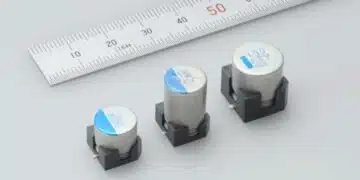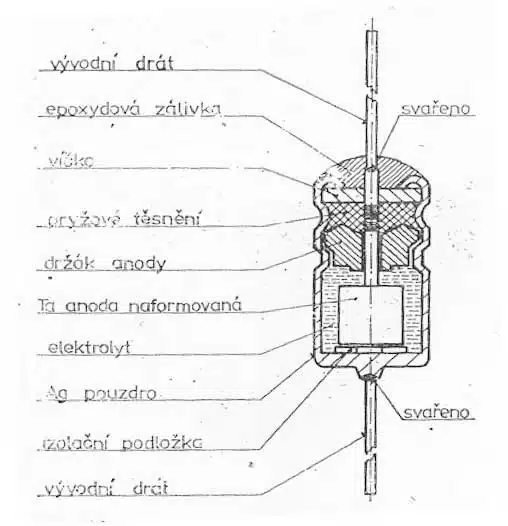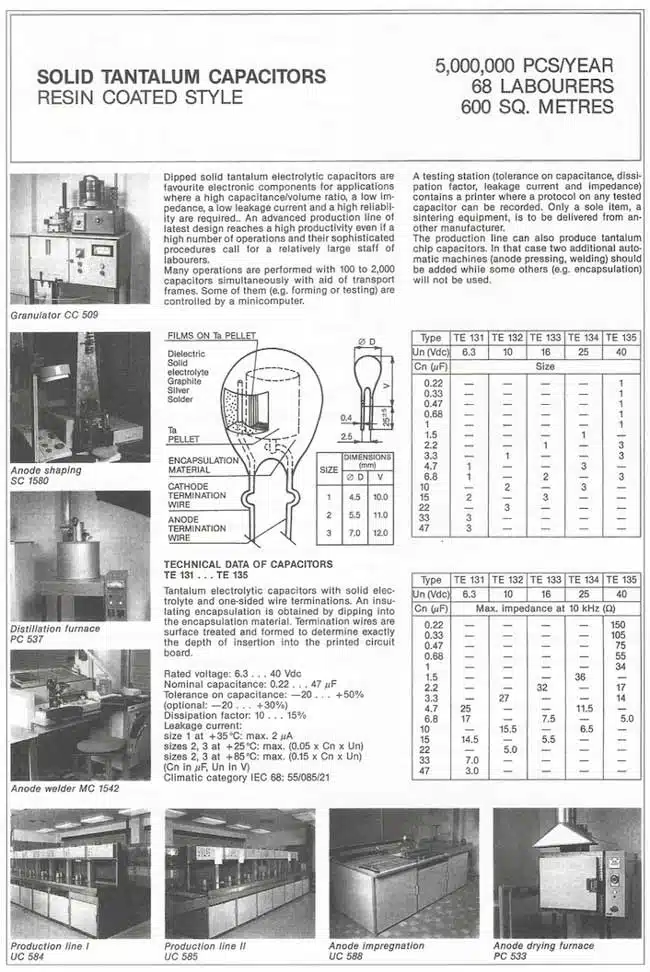This article was written by Tomas Zednicek Ph.D., EPCI European Passive Components Institute, based on historical documents that described the history of tantalum capacitor manufacturing by the TESLA company in Lanskroun, Czech Republic.
Introduction
TESLA Lanškroun manufactured a wide range of passive electronic components, including tantalum capacitors, for almost five decades of the 20th century. The company’s success was driven by dedicated engineers and technical staff who relentlessly pursued improvement and innovation without today’s PC or internet support tools. Each day presented challenges that demanded technical prowess and an unyielding spirit. This article is a tribute to their skills, including my father, who worked there in a capacitor reliability lab.
The beginnings of the TESLA Lanškroun plant
During the Second World War in 1944, the plant for the production of aluminum electrolytic capacitors of the company Siemens und Halske in Berlin – Charlottenburg was bombed. In order to maintain production for military purposes, production was moved to the tobacco factory of the small town of Lanškroun in eastern Bohemia. The newly introduced production of capacitors masked itself under the cover name Betrieb Tabakfabrik Landskron.
After the end of the war, there were more such plants, specialized only in a very narrow field of passive components, in the territory of Czechoslovakia. According to the agreements between the Allies, the equipment of these plants was to be seized by the Soviet Army as compensation for war damages. At the request of the Czechoslovak government, some plants whose products were necessary for the Czechoslovak national economy were exempted from seizure. Among them were several plants for the production of passive components, including the plant in Lanškroun.
In pre-war Czechoslovakia, the only larger company specializing in the production of passive components on a wider scale was the ALWAYS company in Karlín, Prague, however, after the Second World War, there were more plants relocated from the territory of Germany. The original tobacco production in Lanškroun was not restored, and the production of all passive components was concentrated in the vacant premises based on the decision of the Minister of Industry from 4/5/1946. The plant, specialized in the production of passive components, was then incorporated into the national electrotechnical company TESLA.
In 1951, when the concentration of the production of passive components had already ended in the then TESLA Lanškroun, the production program included:
- electrolytic aluminum capacitors;
- paper dielectric capacitors with metal foils;
- MP-capacitors with metallized paper dielectric;
- MICA capacitors
- anti-interference and circuit protection components;
- carbon film resistors;
- wirewound resistors;
- cermet potentiometers;
- wire potentiometers;
- iron cores
Products from the Lanškroun plant were sold on foreign markets almost throughout Europe and South America. In the first half of the 1950s, they carried the TESLA – ALWAYS brand, because the ALWAYS brand had been known abroad since before the war, while the TESLA brand was only slowly gaining ground.
Unlike other manufacturers who bought licenses and machinery, TESLA Lanškroun followed its own path of development of both the components themselves and the development of their own single-purpose machines and modern lines for their production.
TESLA Lanškroun expanded its production program until the revolution in 1989, when at the beginning 90’s of those In the 20th century, there was a decline in the markets of the socialist bloc and the loss of traditional markets. TESLA Lanškroun tried to restructure and enter occupied Western markets. A number of successor organizations separated from the company, which independently or as new plants of important foreign companies continued the tradition and local experience with the production of passive components. One of the important ones was the world’s leading manufacturer of tantalum capacitors – AVX Corporation. However, TESLA Lanškroun, as a brand of a large manufacturer of passive components, was gradually heading towards its demise at the end of the 90s, i.e. to a successful transformation into new specialized companies.
Production of tantalum capacitors
TESLA Lanškroun plant started production of tantalum electrolytic capacitors with liquid electrolyte in 1963. The development was carried out by the Research Institute for Communication Technology (VUST) based on a similar capacitor of the same design, manufactured in the USSR. Their construction was robust and labor-intensive, based on the design solution of Plessey (UK) (later Arcotronics, bought by KEMET). These first mushroom-shaped TC 951 and TC 955 capacitors (Fig. 2) were produced in a voltage range from 4V to 70V and a capacitance of 5 to 80uF.
The design was demanding on the consumption of expensive tantalum material, as the tantalum lid, which was an essential part of the sealing system, was significantly heavier by weight exceeded weight of the functional part of the anode. Their anode termination was made from a tantalum wire pressed into the anode. The wire was welded to the tantalum cap. A tin soldered copper wire was the other side termination lead. There were two cases: outer steel and inner silver. The steel case had a flared neck, insulated inside with a strip of teflon washer. A silver case with a collar around the edge fitted into the outer steel case. A rubber ring rested on the collar of the silver case, on which lay a tantalum disk with a sintered anode. A textile ring rested on it, fixed by turning the edges of the steel case inwards. The space above the tantalum lid was filled with an epoxy potting compound.
However, the capacitors of this design suffered from a significant “wear-out” defect—an undefined loss of capacity with time.
The developers at TESLA Lanškroun made a change in the design (Fig. 4.). They removed the outer steel case and the tantalum lid. The tantalum wire coming from the anode was welded directly to the solder coated copper lead wire. The anode rested on a teflon washer at the bottom of the silver case. The case was closed by an insulating insert, which rested on a groove pressed into the case bottom. A rubber plug rested on the insulating insert, and a textile disk pressed against it with the edge of the case circled inwards. For a more perfect seal, one more groove was pushed into the housing, which was pushed into the plug. (See Fig. 5.)
With this new design, the capacitors became significantly cheaper and the technical parameters were also improved. However, the problems with the sudden loss of capacitance did not go away. It took an entire decade of development before the primary mechanism responsible for this degradation was identified, namely the electrode interlayer between the case and the electrolyte.
By adding a palladium-based depolarizer, this phenomenon was eliminated, and the capacitors have since been characterized by the high reliability typical for tantalum capacitors.
The type TE151 to TE158 was produced from 1970 in a voltage of 4-70V with a capacitance of 5-70uF. The gradual development increased the capacity, voltage and reduced the ESR.
Special types with a larger temperature range were used in military applications. This design was used until 1993, when their production was suppressed based on an agreement with AVX.
Tantalum capacitors with solid electrolyte
The beginning of the production of tantalum capacitors with a solid electrolyte dates back to 1966. The first types of capacity 10-50uF for a voltage of 6-25V were developed in VUST as a solid design with MnO2 electrolyte in an axial design with a length of 17mm and a diameter of 5mm. The production of these capacitors was not adopted into the mass production due to their high labor and high price. TESLA Lanškroun decided to stay with liquid electrolytes with very low leakage current for the strategy of larger axial capacitors and to use the solid electrolyte technology to support the miniaturization of electronics in the form of “drops” or “pearls” radial capacitors.
Subminiature “drops” tantalum capacitors from TESLA own development became the basis of serial production, which entered prototype production in 1971 under the series TE121 to TE125. (Fig. 6.).
The construction was gradually improved. Experiences were also shared among other companies within socialist countries, e.g. with the Polish company ELWA, which in 1975 bought a license for drop capacitors from the Sprague company and also started the production of drop tantalum capacitors to cover the growing needs of the Eastern Bloc countries.
With development, the dissipation factor in particular was constantly reduced for the new TE131-135 series. Design changes mainly involved the surface materials, in the original design, dipping was used, in the newer version, fluidization.
Chip tantalum capacitors
Tantalum capacitors with a solid electrolyte were also produced in the form of chips without surface protection, intended for assembly into hybrid integrated circuits, which were also produced at the Lanškroun plant. They were connected to the integrated circuit by gluing with conductive epoxy and soldering the output wire.
In 1987, tantalum SMD moulded chips were developed at TESLA Lanškroun and introduced into prototype production in 1990. In 1993, this production was discontinued following an agreement with AVX Corporation, which took over all activities related to the production of tantalum capacitors.
AVX branch plant in Bislohe, Germany started cooperation with TESLA Lanškroun since 1990. In 1993, after successful cooperation and mutual agreement, the complete production of tantalum capacitors with over 1000 employees was transferred to the independent company AVX Czech Republic s.r.o. and production under the TESLA brand was discontinued.
Resources:
- Ferdinand Jíra: TESLA Lanškroun, History and present production in the years 1946-1982; Tesla world, company magazine TESLA Lanškroun year 1981 issues 22-49, 1982 issues 1 to 31
- Ing. Jiří Kohout: TESLA Lanškroun 1946-1989 – memories of witnesses; 2007
- Ing. Ladislav Výtisk; Tantalum electrolytic capacitors; Proceedings 6/91 Czech Electrotechnical Society, TESLA Lanškroun branch







































